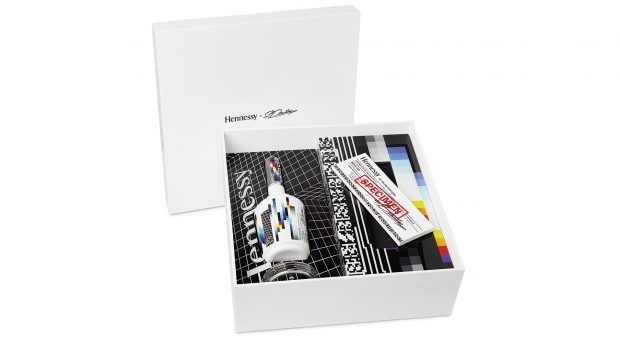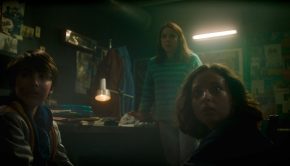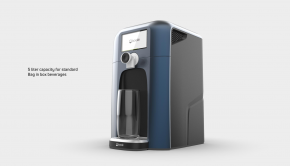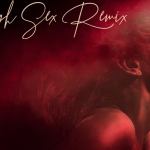A Look At Artist Felipe Pantone’s Latest Project With Hennessy & His June 2019 “Hype” Interview
In May 2018, a groundbreaking exhibition heralded as “the biggest graffiti and streetart show ever” opened in Los Angeles, entitled Beyond The Streets. This 40,000-ft² multimedia showcase came with bold ambitions: to portray graffiti’s 50-year evolution and “celebrate the soaring heights to which the world’s most recognizable modern art movement has risen.” That entailed assembling scores of works by 100 legends of graffiti and street art, living and deceased, from Cornbread, TAKI 183 and Jean-Michel Basquiat, to FUTURA 2000, Vhils and Shepard Fairey. Yet, one of the event’s largest installations wasn’t created by any of those icons, but rather by a star whose own meteoric, peripatetic career personifies just how far graffiti has come and where it is headed next: Felipe Pantone.
Felipe Pantone, it seems, has been encapsulating his era since he first picked up a crayon. Even as a child, it wasn’t dinosaurs and teddy bears, but images of modern life he drew, from the electrified logos of 1980s heavy metal bands to the pixelated characters of Mortal Kombat video games. Ask him where he is from, and he will likely proclaim himself a “child of the internet.” Press a little, though, and he will admit he was born in 1986, in an Argentina rocked by dictatorship. At 10, he moved with his family to Spain in search of a better life. In the bustling port town of Alicante, Felipe’s parents found work, and on the city’s walls, he discovered something new to draw: graffiti. At 12, he painted his first tag. Over time, he would gain renown in the graffiti community as “Pant1,” developing an arresting, avant-garde hand style, and traveling the world with such celebrated crews as D.O.C.S and UltraBoyz.
Earlier this year, Pantone became the latest top-tier artist to collaborate with Hennessy. Following the 9th edition of the Hennessy V.S artist series, Pantone has sincereturned for another Hennessy collaboration. Drawing on Pantone’s signature configurable art series, which allows customers to create custom artwork using Pantone’s templates, Collector’s Edition configurable art lends itself to multiple optics which invite viewers to transform its graphics at leisure. The carafe stands dressed in white at the center of the artwork, with multi-colored rods surrounding the piece, which can be interchanged to the observer’s desire. As a piece of configurable art, it reflects the continuous movement of the world around us, inviting people everywhere to participate in shaping its form.
I conducted an interview with Felipe Pantone in June 2019 for The Hype Magazine, which has been reprinted below in celebration of his new collaboration with the award-winning Hennessy.
How did this collaboration with Hennessy come about?
Felipe Pantone: One of the main reasons is that I’d known about Hennessy’s partnership with urban arts for a very long time. This is something that is very well known in my circles, the way they work with artists, respect them, bring them into another world and make bridges between their craft and art. That was decisive for me. There is a list of 8 people before me that are the top 8 in my field. So you want to be the next one!
A collaboration with Hennessy beats every other of its kind, anything is possible. Judging by the people who did it before, I knew it was going to be very free, creative, and supportive, and I am finding that’s the way it is. I have come up with a project and they are supporting it. I find that fantastic.
When you are creating a specialized work, like you did for Hennessy, is the creative process any different for you than a mural or another sort of project?
Felipe Pantone: I knew right away that it was going to be interesting because there was no agency acting as an intermediary. There was a direct relationship between them and me since the beginning. Hennessy dedicates a whole team to work alongside me, they invest a lot of means, time and interest in the collaboration. It means they care, it’s important for the brand. And at the end of the day, when you are working together, that is what matters. It counts a lot for me. The main piece of art we used for the bottle reflects my characteristic style. But I chose it because I thought it was very suitable. It’s the line of work that I continue to explore, and it’s also what Hennessy liked.
How did you come up with your name?
Felipe Pantone: I have two answers to that, would you like the true version or the fake one? (laughs) I will start with the fake one. Perhaps you’ve heard of the company Pantone, which designs such beautiful colors? Well, I decided to take the brand’s name for my own… Actually, no. The truth is that I just picked the letters randomly, P-A-N-T, and then, like many graffiti writers, I added “one.” And Pantone was born. In the end, what originally seemed like a rather dim-witted name magically turned out to be quite cool.
So you travel frequently to create art?
Felipe Pantone: I am very comfortable living on airplanes and working on a million projects at the same time, just staying connected to this modernity, being part of this perpetual movement. So it feels natural to talk about that, in words and art. And I believe it all began with my background in graffiti. Every graffiti kid is used to traveling, being on trains, never standing still, trying to paint everywhere, to be everywhere. It’s about staying very loose, and I think that is the very essence of these times – to be simultaneously loose and connected.
🗣️ Heading to #Rockin2019? Will call tickets purchased through @ticketfly can be picked up at the concert on June 16, or at @townballroom from June 10 to 14 from 12 to 5 pm. While you're there, check out Felipe Pantone's "Optichromie—BUF," 2019. pic.twitter.com/eJQ6aXeulN
— Albright-Knox (@AlbrightKnox) June 13, 2019
And you discovered graffiti soon after you arrived in Spain?
Felipe Pantone: Correct. My family settled in Alicante. It is essentially a cheap holiday town, but one thing that makes it interesting is its graffiti. A lot of foreigners and people from Madrid have holiday homes there. And the Madrid kids especially that came down brought their graffiti techniques, and you would simply see it everywhere. So all my friends and I decided we needed to have our own graffiti names too, and started to write it on the walls. That was how I learned graffiti.
What was your graffiti writing in the streets like back then?
Felipe Pantone: I’m sure I tried every style in existence. Every color, every letter. When I came up with the 3-D giant letters, I thought they were really “loud.” And when you are working on walls, the whole concept is precisely that — to be seen, to be heard. Therefore, you’ve got to be loud enough. I developed my own style. I realized if I painted letters in extremely vivid colors, and put a black and white pattern just next to them, then people would see and look more closely at my pieces; more than they would at the graffiti someone else made next to mine.
What have you learned from creating graffiti?
Felipe Pantone: Graffiti definitely taught me a lot. In some ways, I’ve come to see it as a kind of childish game to just proliferate one’s name – but that is also the beauty of it. There is zero artistic pretention to it; nobody is trying to make “art” per se. Which is part of what makes it so phenomenal. Because like it or not, I can’t recall any other movement in art history that had so many adepts: we are talking about hundreds of thousands of young people all over the world painting walls… Today, art institutions have only just begun to take full measure of this movement, and to recognize that it must be taken seriously.
Can you tell me about your latest book, Dynamic Phenomena?
Felipe Pantone: That was also the title of an exhibition I did with my gallery in Paris, Magda Danysz. It references both a philosophical point of view and also a description of the pieces that were in the show, which involved dynamism in a physical way. More fundamentally, dynamism is one of my mottos; it’s something that I am always speaking about.
Finally, Felipe, any last words for the kids?
Felipe Pantone: I want people to take away from my work that the beauty of abstract visual art is that I don’t have to reveal my intentions. I can simply use a certain aesthetic, which evokes a larger issue, to raise awareness about a theme. But I do want people to think about these things that matter to me: the transformation, dynamism of this era, and about why in everything we do, from how we open a new business to how we mix a new drink, it is important to be free, and belong to the present — to play with it.






























